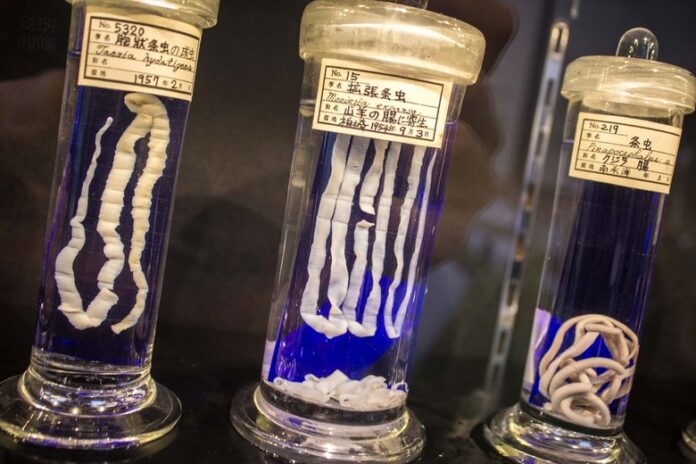According to the Oxford English dictionary, a museum is “a building in which objects of artistic, cultural, historical or scientific interest are kept and shown to the public”. Now, if you could build any kind of museum, what would it be about? Yours might be that of paintings or stones, but let’s think of something unique. How about parasites?
Located in the center of the metropolitan city of Tokyo, Japan, Meguro Parasitological Museum addresses nothing but parasites. Of the six-storied building, first and second floors are allocated to exhibit approximately 300 parasite specimens collected in and out of Japan as well as related materials. The first floor provides us with the general idea of parasites with a special emphasis on the diversity of parasites. With the theme “Human and Zoonotic parasites”, the second floor focuses on the parasite life cycles and the symptoms they cause during human infection. We can also learn about the history of parasitology in Japan.
Back in 1953, Meguro Parasitological Museum was established by the private fund of a medical doctor, Satoru Kamegai. After graduating from Nagasaki medical school, he went to China and continued his research on parasites during the second world war. On returning Japan, he opened a pediatrics clinic in Meguro before establishing his museum. To store the increasing amount of resources and specimens, the museum was rebuilt to the current six-storied building in 1992. It now has staggering 60,000 parasite specimens and 16,000 related books. Being authorized as a public interest incorporated association in 2013, the museum continues to expand its contribution to society through research, education, and publication.
Although I visited the museum with my father four years ago, taking advantage of my free time after school, I decided to go there once again to better understand the atmosphere of the museum. It took me a bit of courage to get into the building. How would people feel when they see this: a high school student with a school uniform coming to a small parasitological museum on Saturday afternoon soon after it reopened after the closure due to COVID-19. Since the entrance fee was free but the donation was welcomed, I put 100 yen (around 1 dollar) in the donation box. The museum itself was not so big, which made me understand why making an appointment was recommended when we plan to visit it with a group.
However, “the parasite world” the museum offered was enormous. On entering the first floor, which addresses the diversity of parasites, I could not help but doubt if it only exhibits parasites. But wherever I go, only I could see were parasites. I felt as if the one-page long description of parasites in the biology textbook extended to the entire floor. I then went upstairs to see one of the most famous and fascinating specimens in this museum: 8.8m long tapeworm. Although most of the memory about my last visit had decayed, I could vividly remember the astonishment I had had when I saw it for the first time, so I was excited. The tapeworm awaited me at the very last section of the second floor. It initially looked like a long tape as the name suggests, but then it reminded me of a long intestine that herbivorous animals have. It took me a while to finally come to believe that it was a parasite.
I dropped in the museum shop when I found the same ruler I used: a 15cm-long plastic ruler with small pictures of six parasites. My father bought it for me four years ago and it became my favorite. However, the scale on the ruler was peeling off, which made it useless in drawing a figure in physics class. So, I decided to buy a new one. There were guidebooks, pencils, and even T-shirts all had a picture of some kinds of parasites.
I heard that the museum was avoided by being called unpleasant at first, but soon became one of the most popular places to visit in Tokyo, with more than 70,000 visitors annually. To meet the increasing demand of the visitors, it started to offer explanations of the exhibit in eight languages, including English, Chinese, and Korean from March 2019. I believe it will continue to attract people from all over the world with its incredible resources on parasites as well as its uniqueness.
Living in busy cities and buying ready-to-eat foodstuffs, we tend to forget the connection to nature. However, this museum taught me that my body itself was a fascinating parasite museum with more than 100 types of them being born and dying each day. It made me realize that we are indeed part of the great nature. Taking the crowded train on my way home, I could not help but imagine tens of thousands of parasites enjoying their own lives in people around me.
By Hana Matsuda, Japan











